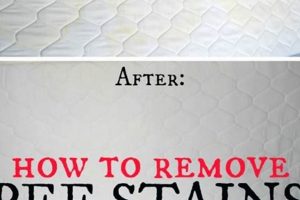Proper disposal of large items like bedding in New York City is governed by specific regulations. These regulations aim to prevent illegal dumping and promote environmentally responsible waste management. Adhering to these guidelines is essential for residents looking to discard a mattress within the city limits.
Following established protocols for discarding bulky waste items contributes to the overall cleanliness and sustainability of the city. Illegal dumping can result in fines and negatively impacts community health and aesthetics. Utilizing available resources and services ensures responsible waste handling and supports environmental protection efforts.
The following sections will detail the methods available for mattress disposal, including options for donation, recycling, and scheduled waste collection, along with pertinent regulations and associated costs.
Tips for Mattress Disposal in NYC
Navigating the disposal of a mattress within New York City requires understanding local regulations and available resources. The following tips provide guidance on compliant and responsible mattress removal.
Tip 1: Research Local Regulations: Prior to any disposal action, consult the New York City Department of Sanitation (DSNY) guidelines. These guidelines outline acceptable disposal methods, including wrapping requirements and collection schedules.
Tip 2: Explore Donation Options: Consider donating a gently used mattress to a local charity. Organizations such as Housing Works or the Salvation Army may accept mattress donations that meet their standards for cleanliness and condition. Contact the charity beforehand to confirm their acceptance criteria and schedule a drop-off or pick-up.
Tip 3: Investigate Recycling Programs: New York City offers mattress recycling programs that dismantle and repurpose the components of discarded mattresses. Search for local recycling facilities that accept mattresses and inquire about their fees and procedures. Utilizing recycling programs minimizes landfill waste.
Tip 4: Schedule a Bulk Waste Collection: If donation or recycling is not feasible, schedule a bulk waste collection with the DSNY. Adhere strictly to the scheduled date and time, and ensure the mattress is properly wrapped in plastic to prevent the spread of pests and moisture. Failure to comply may result in fines.
Tip 5: Utilize Professional Removal Services: Several companies in New York City specialize in mattress removal. These services typically charge a fee but offer the convenience of pickup and proper disposal, often including recycling or donation when possible. Obtain quotes from multiple providers to ensure competitive pricing.
Tip 6: Properly Wrap the Mattress: Regardless of the disposal method, encasing the mattress in a plastic mattress bag is crucial. This prevents the spread of bedbugs and protects sanitation workers from potential contaminants. Secure the bag tightly with tape.
Tip 7: Avoid Illegal Dumping: Abandoning a mattress on the street or in public spaces is illegal and subject to fines. Always use a permitted method of disposal to avoid legal penalties and environmental damage.
Adhering to these tips ensures the proper and responsible disposal of a mattress within New York City, contributing to a cleaner and healthier environment.
The subsequent sections will explore specific resources and contact information for facilitating compliant mattress removal.
1. DSNY Regulations
The New York City Department of Sanitation (DSNY) regulations are paramount to properly managing mattress disposal. These regulations directly dictate approved methods, preparation requirements, and timing constraints for discarding mattresses. Non-compliance can result in fines and refusal of collection. For example, mattresses set out without proper wrapping are often left uncollected, resulting in violations. Understanding these regulations is therefore a fundamental element of compliant mattress disposal.
DSNY regulations address specific concerns such as pest control and worker safety. The requirement for mattress wrapping in plastic serves to prevent the spread of bed bugs and other pests during handling and transport. Specific collection schedules are also established to optimize waste management logistics. Following these guidelines ensures mattresses are handled responsibly and efficiently, contributing to public health and sanitation goals.
In summation, DSNY regulations are not merely procedural requirements; they are integral to responsible mattress disposal in New York City. They directly influence disposal methods, timing, and preparation. Adherence prevents penalties and contributes to community health and sanitation. Consequently, understanding and complying with these regulations is essential for any resident needing to dispose of a mattress.
2. Donation Options
Donation represents a viable and responsible method for mattress disposal in New York City, offering an alternative to landfills while providing support to individuals and organizations in need. Considering donation options aligns with sustainable waste management practices and contributes to community well-being.
- Eligibility Criteria for Donation
Charitable organizations have specific requirements regarding the condition of donated mattresses. Mattresses must typically be free from stains, tears, infestations (e.g., bed bugs), and excessive wear. Organizations like Housing Works or The Salvation Army often have detailed guidelines on their websites or can be contacted directly to ascertain eligibility. Failure to meet these criteria renders a mattress unsuitable for donation, necessitating alternative disposal methods.
- Benefits to the Community
Donating a gently used mattress provides affordable bedding to individuals and families transitioning out of homelessness, escaping domestic violence, or facing financial hardship. This assistance can significantly improve their quality of life and contribute to their stability. Organizations distributing donated items often work with vulnerable populations and have established networks to ensure resources reach those who need them most.
- Tax Deductions and Incentives
Donating a mattress to a qualifying charity can result in a tax deduction. The value of the deduction is based on the fair market value of the mattress, considering its age, condition, and original purchase price. Obtaining a receipt from the charity is essential for claiming the deduction. It is crucial to consult with a tax professional for guidance on maximizing potential tax benefits.
- Logistical Considerations for Donation
Transporting a mattress for donation requires planning and physical effort. Individuals may need to arrange for transportation themselves or inquire whether the charity offers pickup services. Many organizations have limited capacity for pickups and may require donors to deliver items to their designated locations. Additionally, protecting the mattress during transport with a mattress bag is advisable to maintain its cleanliness and prevent damage.
Exploring donation options provides a responsible and socially beneficial pathway for mattress disposal within New York City. By adhering to donation criteria and logistical considerations, residents can contribute to community support initiatives while responsibly managing unwanted mattresses.
3. Recycling Centers
Recycling centers play a crucial role in responsible mattress disposal within New York City. They provide an environmentally sound alternative to landfilling, aligning with the city’s sustainability goals and reducing the strain on waste management infrastructure. Utilizing these centers is a key aspect of properly disposing of a mattress.
- Component Separation and Material Recovery
Mattress recycling centers dismantle mattresses into their constituent materials: steel springs, foam, fabric, and wood. These materials are then processed and repurposed into new products. Steel can be melted down for new metal goods, foam can be shredded for carpet padding, and fabric can be used in various manufacturing applications. This process significantly reduces the demand for virgin materials and conserves natural resources.
- Reduction of Landfill Volume
Mattresses are bulky items that take up considerable space in landfills. Their slow decomposition rate further exacerbates the problem. By diverting mattresses to recycling centers, the volume of waste entering landfills is substantially reduced, extending the lifespan of existing landfill facilities and minimizing the need for new ones. This is particularly important in densely populated urban areas like New York City, where landfill space is a premium.
- Job Creation and Economic Benefits
The mattress recycling industry creates local jobs in dismantling, processing, and transporting materials. These jobs provide employment opportunities for individuals and contribute to the economic vitality of the community. Moreover, the sale of recovered materials generates revenue that supports the operations of recycling centers and stimulates the local economy.
- Compliance with City Regulations and Sustainability Goals
New York City has implemented policies to promote waste reduction and recycling. Utilizing mattress recycling centers helps residents comply with these regulations and contribute to the city’s sustainability goals. By choosing recycling, residents actively participate in creating a more environmentally responsible and sustainable urban environment.
The utilization of recycling centers is not simply an alternative to landfilling; it is a strategic approach that contributes to resource conservation, economic development, and compliance with citywide sustainability initiatives. For individuals seeking ways to responsibly discard a mattress in New York City, recycling centers represent a vital component of the solution.
4. Bulk Pickup
Bulk pickup services, particularly those offered by the New York City Department of Sanitation (DSNY), are a primary method for residents to dispose of large items such as mattresses. This service provides a structured and regulated pathway for discarding items that cannot be accommodated by regular waste collection.
- Scheduling and Coordination
The DSNY requires residents to schedule a bulk pickup appointment. This process ensures efficient allocation of resources and prevents unauthorized dumping. Residents must adhere to specific scheduling windows and designated collection days. Failing to schedule or adhering to incorrect dates can result in the item being left uncollected and potential fines levied.
- Preparation Requirements
Mattresses designated for bulk pickup must be properly prepared to prevent sanitation issues and ensure worker safety. The DSNY mandates that mattresses be fully encased in plastic to prevent the spread of bedbugs or other pests. The plastic wrapping must be securely sealed to avoid exposure during handling. Mattresses not properly wrapped will not be collected.
- Placement and Accessibility
Residents are instructed to place the wrapped mattress at the designated pickup location, typically the curb, on the scheduled collection day. The item must be accessible to sanitation workers without obstruction from vehicles, trees, or other objects. Failure to properly position the mattress can result in missed collection and necessitate rescheduling.
- Compliance and Enforcement
The DSNY actively enforces regulations related to bulk pickup. Sanitation officers patrol neighborhoods to identify improperly discarded items and issue fines for violations. Repeated offenses can lead to increased penalties and potential legal action. Compliance with bulk pickup regulations is essential to avoid legal repercussions and maintain community cleanliness.
Bulk pickup services, when utilized correctly, offer a reliable means for mattress disposal. Adherence to scheduling, preparation, and placement requirements is crucial for ensuring proper collection and avoiding penalties. These services, therefore, form an integral component of the city’s waste management infrastructure, enabling residents to responsibly dispose of bulky items like mattresses.
5. Professional Services
Engaging professional waste removal services presents a direct and often convenient solution for individuals seeking information on “how to get rid of mattress nyc.” These services specialize in the efficient and compliant disposal of bulky items, offering an alternative to self-managed disposal methods.
- Convenience and Time Savings
Professional services offer convenience by handling all aspects of mattress removal, from pickup to disposal. This eliminates the need for residents to transport heavy items or navigate complex disposal regulations, saving time and effort. For example, residents with limited mobility or time constraints may find professional services particularly beneficial.
- Compliance with Regulations
Professional removal companies are well-versed in New York City’s disposal regulations. They ensure that mattresses are disposed of in accordance with all applicable laws, including proper wrapping requirements and designated disposal locations. This minimizes the risk of fines or legal penalties associated with improper disposal.
- Eco-Friendly Disposal Options
Many professional services prioritize environmentally responsible disposal methods. They may offer recycling or donation options, diverting mattresses from landfills. Some companies partner with recycling centers to dismantle mattresses and repurpose their components, contributing to sustainability goals.
- Cost Considerations
Hiring a professional service involves a fee, which can vary depending on the size and number of items to be removed, as well as the distance to the disposal site. It is prudent to obtain quotes from multiple providers to compare pricing and services. While the cost may be higher than self-disposal, the convenience and assurance of proper disposal may justify the expense for some individuals.
The utilization of professional services streamlines mattress disposal in New York City, ensuring compliance, promoting environmental responsibility, and providing convenience to residents. While cost is a factor to consider, the comprehensive service offered can be a worthwhile investment for those seeking a hassle-free solution when learning “how to get rid of mattress nyc.”
6. Mattress Wrapping
Mattress wrapping constitutes a critical element within the broader process of proper mattress disposal in New York City. The act of encasing a mattress in plastic directly influences its acceptability for collection and subsequent handling by sanitation services. Failure to adequately wrap a mattress can lead to rejection by collection crews, resulting in fines for improper disposal, and necessitates a repeat of the disposal process. This act is therefore not merely a suggestion, but a mandatory component of compliant mattress removal.
The specific regulations surrounding mattress wrapping are predicated on public health and safety considerations. Unwrapped mattresses can harbor bedbugs, dust mites, and other allergens, posing a risk to sanitation workers and the community at large. The plastic encasement acts as a barrier, containing these potential hazards and preventing their spread during transport and disposal. Real-life examples demonstrate the consequence of neglecting this step; uncovered mattresses left curbside often remain uncollected, becoming eyesores and potential health risks within the neighborhood. Furthermore, unwrapped mattresses may contaminate recycling streams, undermining broader waste management efforts.
In conclusion, the connection between mattress wrapping and compliant mattress removal is undeniable. Adherence to wrapping requirements ensures the safety of sanitation personnel, mitigates the spread of pests and allergens, and facilitates the efficient processing of waste. Residents seeking to dispose of a mattress in New York City must prioritize proper wrapping as an integral step in the disposal process, contributing to both individual compliance and community well-being in understanding “how to get rid of mattress nyc.”
7. Avoid Illegal Dumping
The imperative to avoid illegal dumping directly correlates with responsible mattress disposal. Improper disposal of bulky items such as mattresses carries legal and environmental consequences within New York City. Understanding authorized disposal methods is paramount to preventing illegal dumping and its associated penalties.
- Legal Ramifications of Illegal Dumping
Illegally discarding a mattress constitutes a violation of New York City sanitation codes. Such violations carry fines that can escalate with repeated offenses. In addition to monetary penalties, illegal dumping can result in misdemeanor charges in certain cases. Sanitation enforcement officers actively patrol areas prone to illegal dumping and issue summonses for violations. Real-world examples include individuals abandoning mattresses on sidewalks or in vacant lots, subsequently incurring significant fines upon detection.
- Environmental Impact of Illegal Dumping
Mattresses contain materials that do not readily decompose, contributing to landfill overcrowding. When illegally dumped, mattresses can leach harmful chemicals into the soil and groundwater, contaminating the environment. Furthermore, discarded mattresses can become breeding grounds for pests and create unsanitary conditions. This poses a risk to public health and diminishes the aesthetic quality of neighborhoods. Instances of mattresses polluting waterways or disrupting natural habitats underscore the environmental consequences of illegal dumping.
- Economic Burden on Taxpayers
The removal of illegally dumped mattresses incurs costs for the city. Sanitation departments must allocate resources to clean up these sites, diverting funds from other essential services. These costs are ultimately borne by taxpayers. Furthermore, illegal dumping can depress property values in affected areas, further impacting the local economy. The expense associated with remediating illegal dumping sites demonstrates the economic burden imposed on the city.
- Alternatives to Illegal Dumping
New York City provides several legitimate options for mattress disposal. These include scheduling bulk waste collection with the Department of Sanitation, utilizing mattress recycling centers, donating usable mattresses to charities, and hiring professional waste removal services. Choosing these authorized methods ensures compliance with regulations and prevents environmental harm. The availability of these alternatives underscores that illegal dumping is an avoidable and irresponsible action.
The various dimensions of illegal dumpinglegal penalties, environmental harm, economic costs, and available alternativesunderscore the importance of responsible mattress disposal. Residents seeking instructions on “how to get rid of mattress nyc” must prioritize compliance with city regulations and avoid any actions that contribute to illegal dumping. This commitment ensures both individual accountability and the well-being of the community.
Frequently Asked Questions
The following addresses common inquiries related to the compliant and responsible disposal of mattresses within New York City.
Question 1: Is it permissible to simply leave a mattress on the curb in New York City?
No, abandoning a mattress on the curb is generally prohibited. The New York City Department of Sanitation (DSNY) requires adherence to specific guidelines for bulky item disposal. Unauthorized placement of a mattress on the curb can result in fines.
Question 2: What is the correct procedure for disposing of a mattress through the DSNY?
The DSNY mandates that a bulk collection appointment be scheduled. Furthermore, the mattress must be fully encased in plastic to prevent the spread of pests and moisture. The wrapped mattress should be placed at the designated collection location on the scheduled date.
Question 3: Are there organizations that accept mattress donations in New York City?
Yes, certain charitable organizations, such as Housing Works and The Salvation Army, may accept mattress donations. However, the mattress must meet specific criteria regarding cleanliness and condition. It is advisable to contact the organization beforehand to confirm their acceptance policies.
Question 4: Does New York City offer mattress recycling programs?
Yes, mattress recycling programs exist within New York City. These programs dismantle mattresses and repurpose their components. Researching local recycling facilities that accept mattresses and inquiring about their fees and procedures is recommended.
Question 5: What are the potential consequences of illegally dumping a mattress?
Illegal dumping of a mattress can result in fines and, in certain cases, misdemeanor charges. Furthermore, illegal dumping contributes to environmental pollution and negatively impacts community health and aesthetics.
Question 6: Is it necessary to wrap a mattress in plastic even if it appears clean?
Yes, wrapping a mattress in plastic is a mandatory requirement, regardless of its apparent cleanliness. This measure prevents the potential spread of bedbugs and protects sanitation workers from potential contaminants. Failure to wrap the mattress may result in non-collection and fines.
Adhering to these guidelines ensures compliant and responsible mattress disposal within New York City.
The following section provides contact information and resources for facilitating mattress disposal.
Conclusion
This exploration of “how to get rid of mattress nyc” has detailed the regulated processes, emphasizing compliance with DSNY mandates, exploring donation avenues, highlighting recycling facilities, and underscoring the consequences of illegal dumping. Adherence to these guidelines constitutes a civic responsibility and promotes environmental stewardship within the city.
The appropriate disposal of mattresses in New York City requires diligence and a commitment to upholding established protocols. Continued awareness of these regulations and responsible action by residents will contribute to a cleaner, healthier, and more sustainable urban environment for all.







